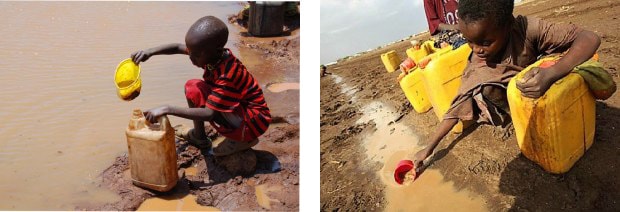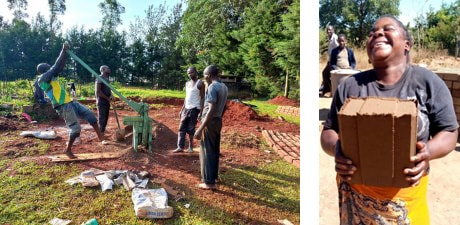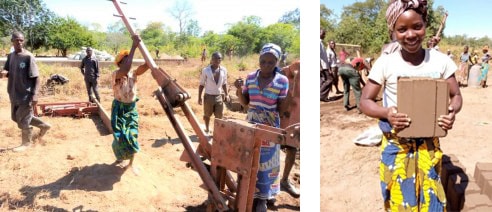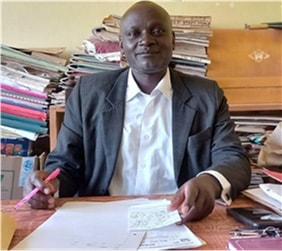By David Albert, Olympia Friends Meeting and co-founder, Friendly Water for the World
(From Western Friend, April 2022, reposted with permission)

Climate change is here. Now. It is not a matter of an occasional snowstorm, hurricane, tornado, or short heat wave. In other parts of the globe, it is now part of the daily struggle for existence.
Friendly Water for the World, a Quaker-founded organization, partners with communities, schools, and families in parts of subSaharan Africa and India. We have seen what is happening at close hand. In central Tanzania, among the Maasai, women, who are used to walking for water every day, leaving at 3 a.m. and returning at noon, now walk as much as 13 hours each night, leaving at 11 p.m., with their daughters taken out of school for this purpose. Each and every night. In western Kenya, a Friends school reports that half of the children are leaving classes to walk for water. In some places, while rainfall hasn’t diminished, it has been concentrated into shorter, more intense periods leading to serious flooding. At the same time, dry periods are becoming longer and longer, leading to crop failures. In Chennai, in southern India, the entire city of more than seven million ran out of water for several months. People couldn’t take showers for weeks; clothes couldn’t be washed; factories shut down; restaurants closed because they couldn’t supply water to their patrons. People left for the countryside, where there was also little water to be found.
Why We Don’t Do Wells
The typical way international development organizations and funders have addressed situations like this in the past is to dig more wells and boreholes. After all, there is water underground (sometimes), and if you dig deep enough…
That’s the way it has always been done. But in many if not most circumstances, as Friendly Water for the World has seen firsthand, it is no longer sustainable.
In many places, aquifers are quickly being drained. Wells are being dug deeper and deeper, in some cases so deep that they are bringing up dangerous levels of arsenic and fluoride, poisoning entire communities, especially children. On the outskirts of cities, water recharge areas are being paved completely over, and rampant deforestation has resulted in quick water runoff, rather than slow percolation through the ground. In shallower boreholes, more of the water is contaminated with animal (and human) feces, increasing the spread of waterborne illnesses like typhoid, cholera, and dysentery. And as more and more people sink wells, they end up unintentionally stealing water from each other, and pitting the needs for water for agriculture and water for personal use in competition with each other.
Wells are expensive to drill. In many places, drilling is controlled by virtual monopolies, placing the cost of drilling beyond the reach of poor communities and families. When they are drilled, in our experience, they are often abandoned after just 2-3 years. Sometimes it is for lack of water. Sometimes because anaerobic iron bacteria are breaking down the underground shafts and pumps. Just as often, however, communities are not given even the least training to perform simple repairs on boreholes or pumps, rendering them inoperable. We have literally scores of photos of abandoned wells put in by well-meaning churches, missions, Rotary Clubs, and others with no money for repairs, and no plan for monitoring or sustainability.
Sustainability Has to Start with Community
On the whole, central governments, large international financial institutions like the World Bank and IMF, and large foundations have failed almost entirely to address these conditions on the ground, especially among the rural poor.

Meanwhile, as individuals, people are often left to fend for themselves. The long walks for water get longer, waterborne illnesses are rampant, kids get taken out of school, and entire families leave for the outskirts of cities, where they attempt (and often fail) to find work as low-wage workers.
But given the opportunity, Friendly Water for the World has found that people virtually everywhere can be resilient, creative, entrepreneurial, motivated, caring, compassionate, and committed. We don’t have to go where there is “need”; there is need almost everywhere we turn. Rather, we start with an approach using Asset-Based Community Development. Put simply, we look for what a community can do, rather than what they can’t.
Besides conducting an epidemiological and community survey, Friendly Water for the World starts with a process of Appreciative Inquiry. Through a three-five day community engagement process involving all segments of the community, we start by everyone acknowledging the individual gifts each brings to table. From our process in Matsakha, a poor community in western Kenya (average income $1.50 per day), held in a Friends church, these are some of the things people offered:
- I am a farmer, and I help provide food.
- I am a village elder, and I assist when conflicts arise.
- I am a widow, and I teach “table banking” to other widows.
- I am a lightning arrestor and rainmaker, and I provide traditional healing.
- I am a business person, and employ people.
- I am a halal butcher, and ensure safe meat.
- I am a housewife, and am a role model to others in ensuring virtue in families.
Then, the community comes to agreement as to what they want to work on. They prioritize among our seven technologies: rainwater catchments; interlocking stabilized soil bricks (ISSBs); soapmaking; rocket stoves; PermaGardens (an adaptation of permaculture for growing food close to one’s home); composting toilets; and water filtration. Or put another way: Water Security; Building Better; Good Hygiene; Clean Water; Improved Sanitation; Safe Cooking; Sustainable Food. Since we expect to be in each community for 3-5 years, it is likely they will get to many if not all of them, provided they become self-sustaining.
Matsakha is a sub-location with ten villages. Representatives of each (most of whom had never met each other before) attended the community engagement. Half of them were women, who bear most of the burden of water- and health-related activities. The chief of the sub-location attended the engagement process and noted that in the 17 years he has been a leader in the area, this was the very first time an organization asked the people what they wanted, before starting. Most other organizations had started programs without consultation, and seemed to come and go as they pleased, with no serious effort at engaging the community.
Soap?!
Somewhat to the surprise of local Friendly Water representatives facilitating the process, the Matsakha community chose to start with soap. The schools were about to reopen post-Covid, and the government required that every school have access to handwashing – with soap – for the students. In addition, it was discovered that there was virtually no soap already in the community. Almost no one washed their hands after using the latrines (the few there are), or before meals. Yet handwashing alone has been shown to reduce the incidence of waterborne illnesses by at least 35%.
Just as critically, the community recognized that producing small quantities of affordable soap to begin with would gain them access to all homes in the community. Everyone would feel included. Following training, the Matsakha Development Group (MDG) was formed (led by two men and two women), with one group of people manufacturing the soap, and the other – mostly young people – taking charge of marketing it. The soap was approved as meeting government standards, labels were designed, and the product quickly earned an excellent reputation. All members of the MDG are paid, and they set up a “table banking” arrangement whereby they could pool their wealth and invest in other community needs. For the first several months, production was subsidized; now they are regularly profitable, with community members having a new source of income they never had before.
Interlocking Stabilized Soil Bricks (ISSBs)
Brickmaking in most of Africa and India is an unsustainable environmental nightmare. Precious trees are cut down to fire the bricks, which are highly uneven, and are then trucked to building sites. Building them requires huge amounts of cement as mortar, and often extremely skilled masons to deal with breakage. In some places, the bricks themselves are still fabricated using slave or bonded labor.

There is another way. ISSBs, made with a combination of subsoil, a small amount of sand, and a small amount of water, are several times stronger than fired bricks, and fit together like legos. Compressed manually, with machines that are entirely portable and utilizing raw materials found at the building site, three people can make up to 400-500 highly uniform bricks a day. Bricks, which cost 23 cents each including paying for labor, can be used to build homes, schools, latrines, clinics, etc. as needed.
In southern Zambia, Friendly Water for the World works with Friends of Monze, a Welsh Quaker organization, which in turn partners with the Zambia Women and Girls Foundation (ZaWGF). Through them, the village of Mungolo contacted us about their desperate need for a school. They live two hours away from the main road, and the Zambian government, already very stretched, said they could not send teachers unless there was a proper school building and houses for two teachers. “School” then consisted of perhaps 50 children sitting under a tree several times a week. With training from ZaWGF and funding from Friends of Monze, with three presses and three teams, and training taking only one day, the community fabricated 16,000 ISSBs in two weeks. Masons trained to use these bricks in under a week proceeded to build a school and two houses for teachers. It took five months in total, with materials sourced from the site itself. There are now 400 children at the school, which is also used as the village’s community center. Not a single tree was felled in the process of brickmaking.
Rainwater Catchment Tanks
Friendly Water for the World worked for several years with local partners to perfect the building of 25,000-liter rainwater catchment tanks, using curved ISSB bricks. This revolutionary process uses virtually no mortar, and the tanks are constructed onsite. Plans and drawings were approved by relevant Kenyan government agencies. These tanks store as much as five times as much water as average plastic tanks, last 2-3 times as long, and cost 60% less.

In Matskaha, there are 13 schools, as well as administrative buildings and markets. Over the period of 18 months, the local communities themselves, with masons and brickmakers trained by Friendly Water staff headed by our Programs Manager Eric Lijodi, who is also Vice Presiding Clerk of Kakamega Yearly Meeting, are constructing some 60 rainwater catchment tanks, most of which will collect rainwater from school roofs. One average-sized schoolhouse can yield over 400,000 liters of rainwater a year in western Kenya. As groups construct the tanks (and workers are paid), each community develops a maintenance and sustainability plan, almost unheard of in the work of other non-governmental organizations.
The local principals, as well as families, are delighted. Students no longer have to leave class to collect water. Schools purchase locally made soap, and children can wash their hands, reducing the risk of transmittable diseases.
There is another major benefit, which at first might seem intangible, but is in fact key. By placing rainwater catchment tanks in public places – schools, clinics, and markets – sustainable practices are promoted to the general community. Sustainable water regains its rightful place as a public, as opposed to private, good, to be protected and advanced by all community members. It becomes a tool for public education, which is critical to combatting and mitigating the impacts of climate change, and promoting sustainability. And it begins to tie sustainability to employment, even – and perhaps especially – among those who are extremely poor.
Partnerships
Programs such as those described above are not possible without extended and extensive partnerships. On the ground, not only do people band together, but they are assisted by local churches and mosques, local governments and programs, and people of goodwill. All Friendly Water for the World staff are native to the countries and, usually, to the communities where we work, which would not be possible without them. And we all become good friends. (It’s in our name!)

Of course, here in the U.S. and Europe, we work hard to extend our partnerships still further. By normal NGO standards, Friendly Water for the World’s budget is very small, made possible by the fact that all the physical work, and on-the-ground planning, are accomplished by people in their own communities. But we have a dedicated and motivated group of supporters, who appreciate the possibility of engaging with communities abroad, and having knowledge of their own personal impact in mitigating the effects of climate change and promoting sustainability. This doesn’t replace work on climate change and sustainability that people are committed to doing here. Rather it extends it further, and increases understanding that we are all in this together.
Recently, we have launched a program to pair Friends Meetings and Friends Churches here with specific efforts abroad, often with other Friends. Orange County Friends Meeting paired up with the program in Matsakha, first to launch the soapmaking project, and now to build rainwater catchment on Friends’ schools. We can make it possible for children and youth at Friends Schools and meetings to engage with children and youth in communities to deepen understanding about climate change and sustainability, and also to create new friendships across the boundaries of nationality, race, and class.
 My name is Jacob Karakacha the head teacher of Namanja Primary School and this is my third year in this school.
My name is Jacob Karakacha the head teacher of Namanja Primary School and this is my third year in this school.
When the information was brought about the construction of the three tanks I was in disbelief because at that time I had dispatched half the school to go and fetch water.
This is a life changing project to the community around this school.
Said a member of Orange County Friends Meeting, “The work of Friendly Water checked all the boxes I want to know when I contribute to an organization. First, it helps real people NOW by finding ways to provide better sanitation and clean water in areas where those are in short supply. Secondly, the projects have far-reaching effects, both across generations and from one village to another. Third, all the projects are developed with sustainable materials and practices. And last, while Friendly Water provides funding and expertise, the decision-making and project oversight are carried out by the communities being served.”
We heartily invite your participation.
To learn more about our work, go to www.friendlywater.org
For an online version of this article in Western Friend: https://westernfriend.org/we-are-all-together
And to contact us about participation in our “We Are All Together” Program and/or to schedule a presentation to your Meeting, contact:
David Albert, Olympia Friends Meeting and co-founder, Friendly Water for the World
Phone: 360 918-3642 e-mail: david@friendlywater.org